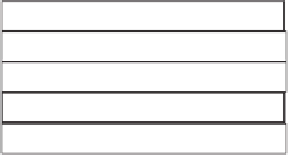Database Reference
In-Depth Information
Leaf Page
Index row
Space for
X new index rows
P% of leaf page
Figure 11.4
Leaf page
split—P and X.
X
=
number of new index rows that can be added to a leaf page after reor-
ganization; our recommendation, as we will see later, will be X
5.
If P
=
10%, leaf page size
=
4K and the index rows are 200 bytes in length,
18 index rows will fit above the P% line (90% of 4K) and so X will be 2.
In addition to P and X, we need two variables to describe the growth of an
index:
=
Y
=
number of index rows added since index reorganization
Z
=
number of leaf pages immediately after reorganization
The number of leaf page splits can now be predicted by a binomial distribu-
tion, assuming the inserts are random. The EXCEL function
BINOMDIST(X,Y,1/Z,TRUE)
determines the probability of a leaf page
not
being split.
For example, let us assume the following: An index, after reorganization, has
1,000,000 rows and 50,000 leaf pages (Z) with P
=
20%; 10,000 new index rows
are added per day (a growth rate of 1% per day); the insert pattern is random;
old rows are not deleted in the foreseeable future.
As there are 20 index rows per leaf page when 80% full, there is room for
five new index rows per leaf page. Therefore X
=
5.
Will there be any leaf page splits during the first 5 days following a reorga-
nization [50,000 inserts (Y)]?
BINOMDIST(5,50000,1/50000,TRUE) =
0.9994
This means that 0.06% of leaf pages will be split during the 5-day period.
The number of leaf page splits will be 0.06% of 50,000 leaf pages
=
30. The
I/O time for an index slice scan will now become
(
1
+
0
.
06
)
×
ORIG, with the
assumptions listed above. This appears to be acceptable.
After 10 days (100,000 inserts), the proportion of leaf pages that have
not
been split becomes
BINOMDIST(5,100000,1/50000,TRUE) = 0.9834






































Search WWH ::

Custom Search